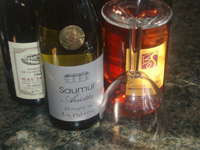Food & Drink - Local wines

The Loire Valley as a whole is France’s third largest region in terms of wine production, and its second largest area producing of sparkling white wines. Many of the Loire Valley wines are made from a single grape variety. Cabernet Franc is the most important red grape used in the Anjou-Saumur and Touraine region, and is closely related to Cabernet Sauvignon, producing mainly light and fruity wines. It is also used in such famous wines as Chinon, Bourgueil and Saumur-Champigny. Many of the other light reds such as Touraine is often made entirely from Gamay grapes. However, some of the best reds locally are made from Cabernet Sauvignon and Cabernet Franc, under the Anjou Villages and Brissac labels, and are drier, more full-bodied and spicier.

This region is traditionally well known for rosé wines based on the Cabernet Franc grape. Various rosé wines are also produced in the region, ranging from delicate and tender rosés like Cabernet d’Anjou and Rosé d’Anjou, to the drier and fruitier Rosé de Loire and Cabernet de Saumur. Cabernet d'Anjou is usually made from a combination of Cabernet Franc and Cabernet Sauvignon grapes, but the drier Rosé d'Anjou is made predominately from Grolleau, blended with other grapes such as Gamay.
Chenin Blanc, (also known as Pineau de la Loire) is used to produce the great sweet dessert wines in the vineyards of Quarts de Chaume, Bonnezeaux, Coteaux du Layon and Vouvray. It is also found in the excellent intensely dry wines of Savennières and in Vouvray. Chenin Blanc is also the main grape used in many of the sparkling wines of the Loire Valley, although other grapes such as Sauvignon Blanc may also be added. Pinot Noir, Cabernet Franc and Cabernet Sauvignon are used in addition in the sparkling rosés.
Sauvignon Blanc grapes are used to provide the distinctive characters of Sancerre, Pouilly Fumé, Reuilly, Menetou-Salon, Quincy and Touraine Blanc. Melon de Bourgogne (better known as Muscadet, the name of the wine that it produces) is the dominant grape of the area around Nantes nearer the coast of Brittany.

The wine area of Anjou-Saumur has 30 different Appellations d’Origine Contrôlée (AOC), offering a wide variety of wines, in terms of colour and flavour, including sweet and dry whites, sweet and dry rosés, reds, and sparkling wines. The grapes most commonly used in this area are: Chenin Blanc, Cabernet Franc and Gamay, but there is great diversity in local wines produced using these three main grape varieties. The chalky tuffeau subsoil of the Saumur area gives the wines their unique character. You can visit the Caves de Vignerons de Saumur in nearby St Cyr en Bourg, to taste some of the wines that are available locally.
The area around Saumur is the third largest sparkling wine appellation in France after the Champagne region and the Crémant d'Alsace AOC with more than 12 million bottles produced each year. Their vineyards extend much further west than those of the other Saumur appellations. It is produced in the ‘methode traditionnelle’, which is similar to the way in which champagne is made and known as “Fines Bulles” or literally fine bubbles. The Saumur sparkling wine production centres around St-Hilaire St-Florent where there are a number of larger well-established quality producers such as Gratien & Meyer, Ackerman and Veuve Amiot which all have organised visits you can go on. Gratien & Meyer also occasionally organise Jazz evenings during summer. Many of the small wine producers around Saumur also have lots of different types of sparkling wines you may wish to try, including a more unusual but delicious sparkling red wine made from the Cabernet Franc grape.
Le Puy Notre Dame has around 70 vineyards, which produce about 12 million bottles a year. It is the main wine producer of Saumur wine and after many years is proud to have finally gained its own AOC (Saumur Puy-Notre-Dame). Although the name was endorsed by the INAO (Institut National des Appellations d'Origine) the governing body of the French appellation system, on 14th June 2006, unfortunately as this organization was dissolved, it was not officially recognised until 14 October 2009.

Saumur Puy-Notre-Dame wines tend to be medium- to light-bodied wines. The main grapes used must be at least 85% Cabernet Franc complemented by up to 15% Cabernet Sauvignon. The wines have a beautiful deep red colour, and are often gently spicy with a nose rich in black fruit (such as blackcurrant, blackberry and cherry), sometimes also tasting of red berry fruits such as raspberries. Those examples from warmer growing seasons, have a well-balanced structure, tending to age well and lasting for between five and ten years.
The catchment area for the Saumur Puy-Notre-Dame wine overlaps slightly with the Saumur red wine appellation, Saumur-Champigny, which produces some of the best red wines in the Loire Valley. Saumur Puy-Notre-Dame is produced in 17 communes south of the Loire: Brézé, Brossay, Cizay la Madeleine, Distré, Doué la Fontaine, Epieds, Le Puy Notre Dame, Les Ulmes, Vauldenay, Les Verchers sur Layon, Meigné, Montreuil Bellay, Berrie, Les Trois Moutiers, Pouançay, Saix and Saint Léger de Monbrillais. There are many very good vineyards locally including: le Domaine de la Fuye, le Manoir de la Tête Rouge, le Vieux Pressoir and le Domaine de Paleine, Château Tour Grise, and Domaine de la Seigneurie des Tourelles.